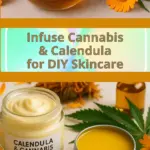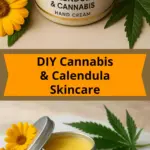Calendula, commonly known as Pot Marigold, is a popular choice for herbalists and people who enjoy creating their own skincare formulations. It’s one of the best plants for your skin! If your hands are dry and chapped this winter, try this Calendula Hand Cream recipe. It’s got great anti-inflammatory and antimicrobial properties, plus it feels super soothing. It’s definitely a must for your natural skincare routine!
In this guide, I’m going to share how you can easily make two powerfully effective products using Calendula. I have a fantastic recipe for a moisturising Calendula Hand Cream, and a versatile Calendula Balm which is multifunctional and perfect for daily use!
Table of Contents
Why Calendula Is Ideal for DIY Skincare
Calendula (INCI: Calendula Officinalis), or Pot Marigold, is a vibrant golden-orange flower used for centuries in herbal medicine and skincare. Calendula, originally from the Mediterranean and now grown worldwide, is valued for its beautiful flowers and beneficial effects on skin.
Historically, Calendula has been used since ancient times for its healing prowess. People in Ancient Egypt loved Calendula because they thought it helped them feel young and fresh. In medieval Europe, folks used it to help heal cuts and calm down sore skin. If you check out Ayurvedic practices, you’ll notice they’ve been using Calendula for a long time to soothe skin inflammation.
Calendula and Cannabis as a Natural Synergy
Calendula is well-known for having a lot of flavonoids, triterpenoids, and carotenoids. These compounds are great for helping your skin heal naturally, calming down redness, and boosting hydration. It’s like a cosy blanket for your skin when it’s feeling cranky, sensitive, or stressed out. If you’ve got dry skin, are dealing with eczema, or just facing those little skin problems that pop up every now and then, this is a great option for you.
Meanwhile, cannabis, specifically hemp-derived CBD (cannabidiol), brings its own strengths to the table. CBD interacts with your skin’s endocannabinoid system (ECS) to reduce inflammation, regulate oil production, and promote calmness in both your skin and body. Its antioxidant properties also protect the skin from damage caused by free radicals.
When combined, Calendula and Cannabis create a beautifully balanced, all-natural skincare base that:
- Soothes Irritation: Calms sensitive, reactive, or inflamed skin.
- Accelerates healing for minor wounds, dry patches, and sunburns.
- Deeply Hydrates: When infused into oils, Calendula nourishes and softens the skin.
- Strengthens the skin barrier, helping to defend against environmental aggressors.
- Rich in Antioxidants: Protects the skin from environmental stress and ageing.
- Gentle for All Skin Types: Ideal for even the most sensitive or delicate skin.
You can soak dried Calendula flowers in oils or water, and there is also a super-concentrated CO2 extract available. However it is used, Calendula is a super powerful ingredient for making your own creams, salves, and balms.
Infusing Cannabis and Calendula Together
Cannabis needs to be decarboxylated before use. The dried plant contains CBDA which gets converted to the desirable CBD when it is heated to a specific temperature. I always use the POT by NOIDS to get this done right. After you’ve decarbed your cannabis, just toss in the dried marigold flowers and pour your heat-stable oil over everything. Run the machine to infuse the CBD oil, then strain the oil using the provided strainer.
Here are full instructions for decarbing and infusing oil and I typically use 1 gram of cannabis for every 1 gram of calendula, but you can easily make these recipes without cannabis if you prefer! They’re still really great formulations. Remember that the dried herbs will absorb some of the oil, so allow for that when measuring.
I frequently use Rice Bran oil as it has a great, non-greasy skin feel, and is loaded with anti-ageing tocotrienols. You could use many other oils such as Olive, Sweet Almond, Sunflower, or even Marula. If you don’t want to use the cannabis, simply use ready infused Calendula Oil (link further down).
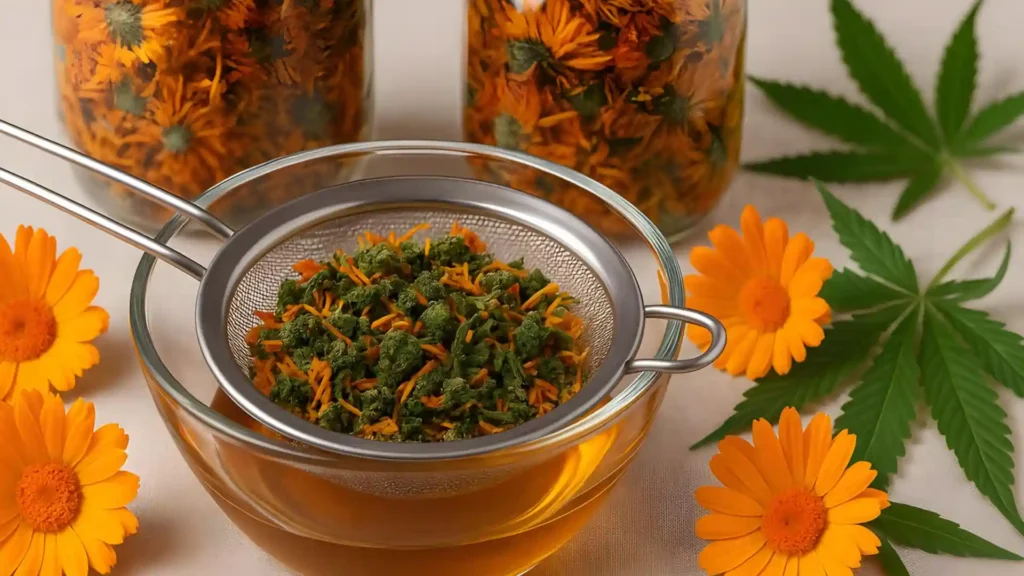
Ingredients Spotlight
Rice Bran Oil
Rice Bran Oil (Oryza Sativa Bran Oil) comes from the outer layer of rice grains. It’s been valued in Japan for centuries for brightening and softening skin. The oil is rich in vitamin E compounds (tocopherols, tocotrienols) and Gamma-Oryzanol, which protect and regenerate skin.
Its fatty acids are balanced, containing Oleic Acid (35% to 50%), Linoleic Acid (29% to 45%), and smaller amounts of Palmitic and Alpha-Linolenic Acids. This makes it nourishing but not too heavy. On skin, it reduces water loss, smooths texture, evens tone, and calms irritation. Naturally SPF 4, it suits sun care and anti-ageing blends, and also conditions hair with softness and shine. It’s heat-stable, so it is ideal for cannabis infusions. Listen to this podcast about Rice Bran Oil for skin and cannabis infusions.
Olive Oil
Olive Oil (Olea Europaea Fruit Oil) is a classic Mediterranean oil pressed from ripe olives. It’s got a good amount of Oleic Acid (about 55% to 83%), and there are also some smaller amounts of Linoleic Acid and Palmitic Acid in it. Plus, you’ll find some nice antioxidants like Vitamin E and polyphenols, too. This composition makes it deeply moisturising and protective, especially for dry or mature skin.
It supports barrier repair, softens rough patches, and has mild anti-inflammatory effects. Olive oil is a great option for cannabis infusion because it handles gentle heat well, helps transport cannabinoids, and adds nutritional benefits. In hair care, it smooths, conditions, and adds shine, though it can feel heavier than lighter carrier oils.
Calendula-Infused Oil
Calendula oil is usually made by cold-macerating Calendula (Calendula Officinalis) petals in a carrier such as high-oleic Sunflower oil. The Sunflower oil brings a light, easily absorbed feel and a high level of Oleic Acid (around 70% to 80%) with some Linoleic Acid, giving skin-softening and barrier-supporting effects. Calendula flowers bring additional compounds like carotenoids, flavonoids, and triterpenes, which are well known for calming inflammation, easing redness, and supporting skin repair. On hair and scalp, it offers mild conditioning and comfort for irritation without heaviness.
The oil soothes sensitive or irritated skin, helps with dryness, and is commonly found in DIY balms, lotions, and baby care products. It’s stable enough for gentle warming, allowing it to be used in a cannabis infusion for added anti-inflammatory and healing benefits. It works very well in this simple Soothing Balm recipe.
Beeswax
Beeswax (Cera Alba) is a natural wax produced by honeybees, and it is gently refined before use. Unlike oils, it is solid at room temperature and is used mainly as a thickener and protective agent in skincare. It forms a breathable barrier on the skin that retains moisture without blocking pores, making it useful in balms, salves, and butters. It contains esters, fatty acids, hydrocarbons, and small amounts of vitamin A, which provide emollient, soothing, and mild antibacterial properties.
In cannabis formulations, beeswax helps set the texture of salves and sticks, while also slowing oxidation of the infused oils. It’s not suited as an infusion medium itself, but blends with carrier oils to stabilise and protect. For hair, it adds light hold and shine in styling balms, though too much can feel heavy.
For a vegan option, try Rice Bran Wax for similar texture and a silky finish.
Montanov™ 68 MB
Montanov™ 68 MB is a natural, palm-derived emulsifier (INCI: Cetearyl Alcohol and Cetearyl Glucoside) used to create stable oil-in-water emulsions. It gives creams and lotions a smooth, velvety texture with a soft after-feel, while helping oils and water blend evenly. Because it is PEG-free and of vegetable origin, it is widely used in natural and organic formulations.
It works with a broad range of oils, including cannabis-infused carriers, and remains stable under gentle heating. Beyond structure, it contributes mild skin conditioning and helps retain hydration by reinforcing the skin barrier. Montanov™ 68 MB is incredibly versatile! You can use it in face creams, body lotions, butters, and serums. It helps create stable emulsions that stay smooth and don’t separate over time.#
If yiou are new to emulsifiers, read my guide to Cosmetic Emulsifiers that work with cannabis.
Vegetable Glycerin
Glycerin is normally produced from slaughterhouse leftovers. I prefer not to use that type, and so I use a plant-based type. Vegetable Glycerin (INCI: Glycerin) is a clear, odourless liquid derived from plant oils such as soy, coconut, or palm. It’s a powerful humectant, which draws water into the outer layers of the skin, keeping it hydrated and supple.
In skincare and cannabis products, Vegetable Glycerin is really loved for its ability to soften dry or rough skin, calm irritation, and help with repairing the skin barrier. It also improves glide and skin feel in gels, serums, and lotions, while helping to preserve moisture balance. While it can’t be used as an oil-based infusion, it works well in the water phase of emulsions or in alcohol-free herbal tinctures. In hair care, Vegetable Glycerin helps reduce frizz, boosts softness, and maintains moisture in curls and dry hair. Read more about Glycerin Benefits for Skin and Hair.
Vitamin E
Vitamin E (INCI: Tocopherol) is a fat-soluble antioxidant usually derived from vegetable oils such as Sunflower or Soybean. In skincare it protects cell membranes and carrier oils from oxidative damage, extending shelf life while also supporting skin repair. When used in your skin care products, it helps fight off damage from free radicals, makes dry or rough patches feel smoother, and can even make scars and fine lines look better.
In cannabis formulations, Vitamin E is often added in small amounts to stabilise infused oils and maintain potency. It blends easily into the oil phase of creams, balms, and serums. For hair, Vitamin E nourishes the scalp, reduces oxidative stress, and promotes shine and elasticity.
Saliguard® PCG
Saliguard® PCG (INCI: Propylene Glycol, Phenoxyethanol, Chlorphenesin) is a broad-spectrum preservative blend used in natural and conventional skincare. It keeps creams, lotions, gels, and serums safe from bacteria, yeast, and mould, making sure they stay good and stable throughout their shelf life. Typically used at 0.5% to 2%, it works across a wide pH range. It’s not high-heat stable, so it is best added during Stage 3 or the cool-down phase. As it is water-soluble, it is easy to use in toners and sprays.
Saliguard® PCG prevents microbial growth in cannabis skincare oil-in-water emulsions and infused lotions, helping to maintain product stability despite the presence of botanical extracts. It does not add texture or scent, but simply secures hygiene and safety in finished formulations. Read more about other Natural Preservatives in Cosmetics.
DIY Calendula Hand Cream Recipe
This rich, skin-repairing calendula hand cream recipe is perfect for dry, cracked hands and can even be used on elbows and heels.
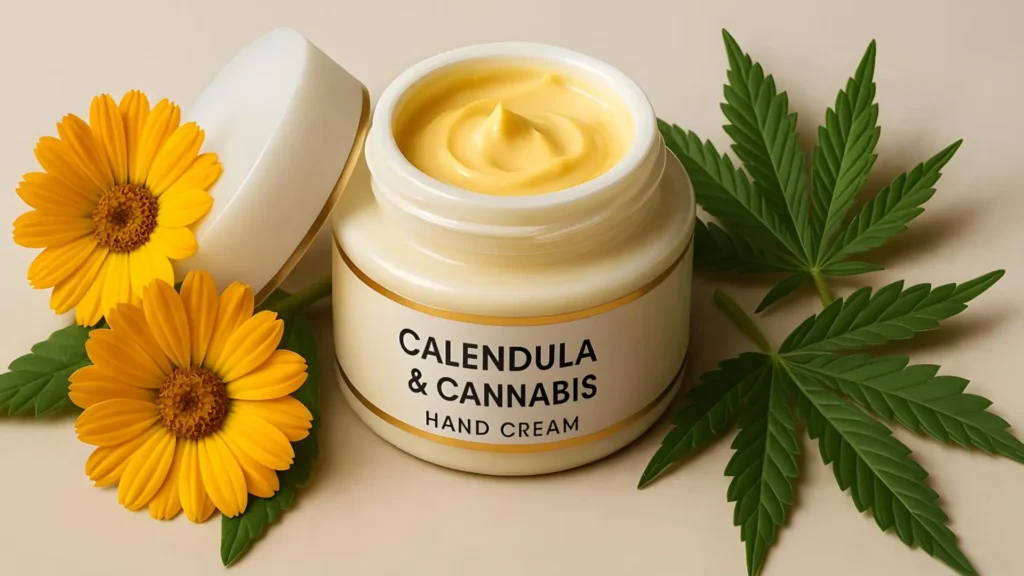
Ingredients:
Stage 1: Oil Stage (above 75℃/167℉)
- 22% Cannabis/Calendula-Infused oil
- 5% Montanov™ 68 MB (natural emulsifier)
Stage 2: Water Stage (above 75℃/167℉)
- 66% Boiling Distilled Water
- 5% Vegetable Glycerin
Stage 3: Cool Stage (below 40℃/104℉)
- 1% Saliguard® PCG (preservative for natural skincare)
- 1% Essential Oils of your choice
100% Total
Method:
- Heat Stage 1 in a bain-marie/double boiler until above 75°C.
- Once Stage 1 has heated, combine the Stage 2 water and glycerin.
- Pour Stage 1 into Stage 2 slowly while stirring and keep on the heat.
- Blend with a stick blender/immersion blender for 30 seconds until smooth.
- Remove from the heat and let the cream cool to under 40°C whilst stirring gently.
- Then stir in Stage 3 ingredients.
- Mix well, jar it, and label your creation.
DIY Calendula Balm Recipe
This balm is perfect for lips, cuticles, dry patches, and wind-chapped skin. It’s simple to make and a great starting point for beginner formulators.
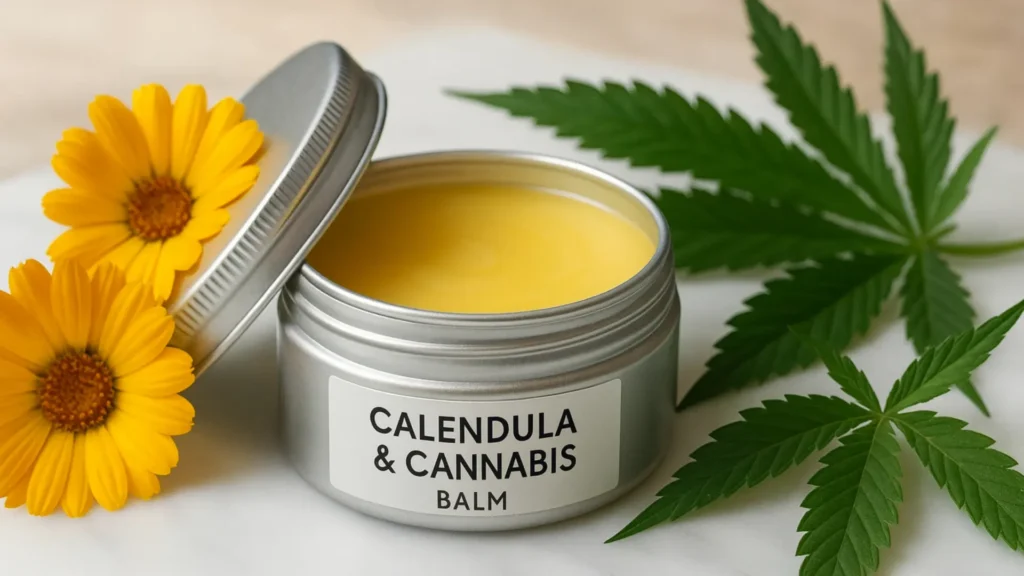
Ingredients:
Stage 1: Oil Stage (heat until melted):
- 45% Olive Oil
- 15% Beeswax
Stage 3: Cool Stage (below 40℃/104℉)
- 38% Calendula Oil or Cannabis/Calendula-Infused oil
- 1% Vitamin E (antioxidant)
- 1% Essential Oils of your choice
Method:
- Gently heat Stage 1 ingredients in a double boiler until melted.
- Remove from the heat and let cool slightly until going opaque at the edges.
- Stir in Stage 2 ingredients and mix thoroughly.
- Pour into small jars or tins.
- Allow it to cool completely before sealing and labeling.
How to Use These Calendula Products Daily
Both the Calendula Hand Cream recipe and Calendula Balm can be used in your regular skincare routine.
- Calendula Hand Cream: Apply after washing hands or before bed.
- Calendula Balm: Use as needed on lips, elbows, cuticles, cracked heels, or dry patches.
These formulas are gentle enough for most skin types, including sensitive skin. Make sure to do a patch test before trying anything new.
Storage Tips and Shelf Life
- Calendula Hand Cream Recipe: Store in a cool, dry place. Use within 12 months.
- Calendula Balm: Because it’s oil-based and preservative-free, it lasts up to 12 months.
Use clean fingers or a spatula to avoid contamination and extend shelf life.
Conclusion
Calendula is a powerful natural remedy for your skin, and when combined with cannabis, it becomes even more remarkable. By adding these gentle plants into your homemade hand creams and balms, you’re doing more than just making nice skincare. You’re also putting together a routine that has a rich tradition, helps with healing, and embraces natural wellness.
The best part? These recipes are simple, effective, and customisable for your needs. If your hands are feeling dry this winter, or you’ve got some areas of skin that need a bit of extra care, Calendula is a great go-to! It’s a great way to add some plant power to your skincare routine.
Try this Calendula Hand Cream recipe and the Calendula Balm and see how easy it is to make soothing, nourishing products at home. Your skin will thank you, and you’ll wonder how you ever lived without this sunny little flower in your life!
🎧 Listen Instead
Prefer listening? Play it here or catch it on your favourite platform:
FAQ
How do you make calendula cream at home?
Infuse calendula in a carrier oil, then blend it with water, an emulsifier, and a preservative to create a rich hand cream.
Which carrier oils work best for calendula infusion?
Rice bran, sunflower, olive, almond, and marula oil are all good options, depending on skin type.
How long will a homemade calendula salve or cream last?
With a preservative, calendula cream lasts up to 12 months. Oil-based balms without water also last about a year.
Can I skip emulsifier or preservative in calendula formulas?
No, the emulsifier is needed to stop separation, and preservative helps prevent spoilage.
How much beeswax should I use in a calendula balm?
About 15% beeswax with 85% oils makes a firm but spreadable balm.
Is calendula balm good for cracked hands?
Yes, calendula balm is often used for cracked hands, cracked heels, dry lips, and other dry patches.
Can calendula cream help with sensitive or irritated skin?
Yes, calendula is gentle and soothing, making it suitable for sensitive or inflamed skin.

If you liked this blog post, I would love it if you shared it with a friend.
If you use Pinterest, please pin this post.
**As a POT by NOIDS affiliate, I earn from qualifying purchases.

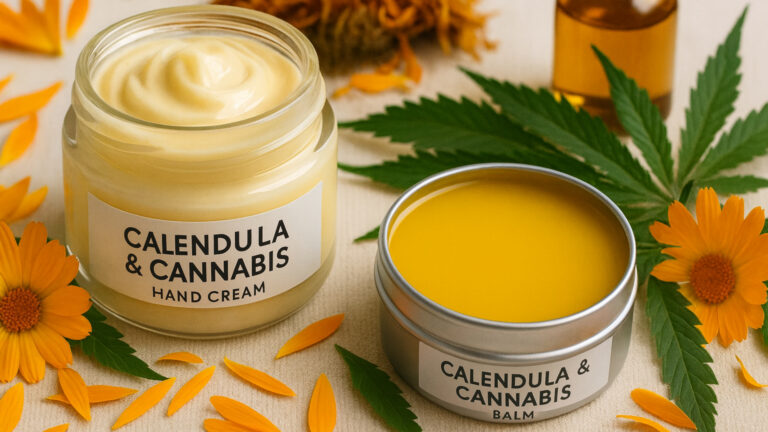
 Spotify
Spotify
